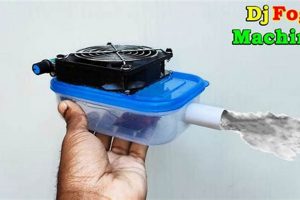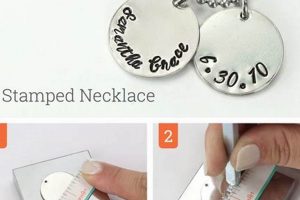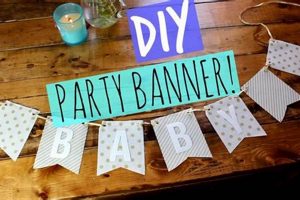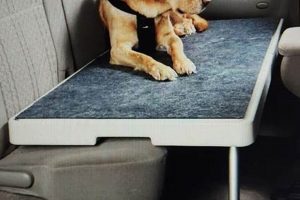The creation of buccaneer-themed garments through do-it-yourself methods involves the modification or construction of attire intended to resemble that worn by pirates of historical or fictional portrayals. An example would be crafting a ragged vest from repurposed fabric or adapting existing shirts with added ruffles and decorative elements.
Engaging in such projects offers a cost-effective and personalized approach to acquiring themed costumes for events, theatrical productions, or recreational activities. This undertaking allows for creativity and customization, enabling individuals to tailor designs to specific preferences or requirements. Furthermore, it provides a tangible connection to historical narratives and popular culture depictions of maritime adventurers.
The following discussion will elaborate on fundamental garment components, material selection, and construction techniques applicable to the successful execution of pirate-inspired apparel projects. The analysis will provide practical guidance for replicating iconic elements and achieving desired aesthetic outcomes.
Guidance on Pirate Costume Construction
The following recommendations aim to provide practical guidance for individuals embarking on the creation of pirate-themed attire, ensuring a robust and aesthetically appropriate final product.
Tip 1: Fabric Selection. Prioritize natural fabrics such as linen, cotton, or muslin for an authentic appearance and enhanced comfort. Weathered or textured materials enhance the impression of age and wear inherent in the pirate aesthetic.
Tip 2: Shirt Construction. Begin with a loose-fitting, long-sleeved shirt. Alter the neckline to a wider, more open style. Add ruffles to the cuffs and neckline for a characteristic flourish. Consider staining the fabric with tea or coffee for a distressed effect.
Tip 3: Vest Design. A vest is a crucial element. Construct a sleeveless garment from heavy canvas or leather. Asymmetrical closures or tattered edges contribute to a rugged appearance. Dark colors such as brown, black, or navy are recommended.
Tip 4: Pant Modifications. Existing trousers can be adapted. Cinch the legs below the knee for a breeches-like effect. Alternatively, create wide-legged trousers using a simple pattern. Tears and patches strategically placed enhance the impression of wear and tear.
Tip 5: Headwear Considerations. A bandana or tricorn hat is essential. A simple bandana can be fashioned from a square of fabric. A tricorn hat can be constructed from felt or cardboard, covered in fabric, and shaped accordingly.
Tip 6: Accessory Integration. Belts, sashes, and pouches are integral. Wide leather belts with large buckles are recommended. A sash can be fashioned from a length of fabric. Pouches can be crafted from leather scraps and attached to the belt.
Tip 7: Boot Selection. Tall boots, ideally knee-high, complete the ensemble. If authentic boots are unavailable, boot covers can be fashioned from fabric and worn over existing footwear.
These guidelines should facilitate the creation of convincing pirate-themed attire, emphasizing authenticity and attention to detail. Through careful material selection and construction techniques, a compelling costume can be realized.
The subsequent section will address specific construction techniques and pattern adaptations applicable to the creation of pirate-inspired apparel.
1. Fabric Selection
Fabric selection constitutes a foundational element in the successful execution of buccaneer-themed garment projects. The choice of material directly influences the aesthetic authenticity, durability, and overall comfort of the final apparel. Inaccurate material selection can result in a costume that appears inauthentic or proves unsuitable for its intended use. For instance, utilizing modern synthetic fabrics, while potentially cost-effective, often results in a visually incongruous outcome when striving for historical accuracy. Conversely, the deliberate selection of natural, slightly textured fabrics, such as linen or coarsely woven cotton, enhances the illusion of age and wear, contributing to a more convincing representation of pirate attire. The inherent drape and breathability of these materials also improve the wearer’s comfort, particularly during extended use in performance settings or costumed events.
The practical implications of informed material selection extend beyond mere aesthetics. The durability of the fabric directly impacts the lifespan of the garment, particularly considering the often-simulated ruggedness of pirate attire. For example, choosing a heavy-weight canvas for vests or breeches increases the garment’s resistance to tearing and abrasion. Furthermore, the colorfastness of the chosen dye is essential; garments intended for outdoor wear require fabrics dyed with solutions resistant to fading from sunlight exposure. The selection of appropriate lining materials also contributes to the garment’s overall structure and comfort.
In summary, the connection between fabric selection and successful buccaneer-themed garment construction is undeniable. Careful consideration of material type, weight, texture, and colorfastness directly impacts the authenticity, durability, and comfort of the final product. Overlooking these considerations can lead to suboptimal results. Prioritizing appropriate fabric selection serves as a crucial step in achieving a credible and lasting representation of historical or fictional pirate attire.
2. Pattern Adaptations
The modification of existing garment patterns or the creation of new patterns is a critical component in the execution of buccaneer-themed apparel projects. The availability of pre-existing patterns often simplifies the construction process; however, these patterns frequently necessitate adaptation to align with the specific aesthetic and functional requirements of pirate attire.
- Sleeve Modifications
Adapting sleeve patterns to create the characteristic voluminous or puffed sleeves frequently associated with pirate shirts requires the insertion of additional fabric or the alteration of the sleeve head. This modification can be achieved by slashing the pattern piece and spreading it to increase the overall width, or by incorporating gathered sections at the shoulder seam to create the desired fullness. In historical examples, such sleeves provided ease of movement during maritime activities. Failure to properly adapt the sleeve pattern can result in a garment that lacks the distinctive silhouette.
- Vest Pattern Construction
The creation of a pirate-style vest often necessitates the drafting of a new pattern, as standard vest patterns may not accurately reflect the asymmetrical closures, irregular hemlines, and overall rugged appearance commonly associated with the pirate aesthetic. Develop
ing a pattern that incorporates these elements requires careful consideration of body measurements and the desired fit. An improperly constructed vest pattern can result in a garment that does not drape correctly or fit comfortably. - Trousers and Breeches Alterations
Transforming standard trouser patterns into the wide-legged trousers or gathered breeches typical of pirate attire demands significant alteration. This can involve widening the leg pattern, cinching the lower leg with ties or elastic, and adjusting the waistband for a more comfortable fit. Historical depictions of pirates often showcase trousers exhibiting these characteristics, providing visual references for pattern alterations. Neglecting to accurately adapt trouser patterns can produce a garment that deviates significantly from the intended pirate aesthetic.
- Headwear Creation
The construction of bandanas or tricorn hats, essential elements of pirate attire, often requires creating patterns from scratch. A bandana pattern is relatively simple, consisting of a square or triangular piece of fabric. A tricorn hat pattern, however, is more complex, requiring multiple pattern pieces to create the characteristic three-pointed shape. The accurate construction of headwear patterns is crucial for achieving the desired visual impact and historical accuracy.
In summary, the effective modification of existing patterns or the creation of new patterns is instrumental in the successful construction of buccaneer-themed attire. These adaptations enable the creation of garments that accurately reflect the distinctive silhouettes and design elements associated with pirate apparel. A lack of attention to pattern adaptations can significantly detract from the authenticity and overall effectiveness of the finished product.
3. Distressing Techniques
The application of distressing techniques constitutes a critical process in the creation of convincing pirate attire through do-it-yourself methods. These techniques intentionally introduce artificial wear, tear, and discoloration to fabricated garments, replicating the effects of prolonged exposure to the elements and the rigors of maritime life. Without such distressing, newly constructed attire appears conspicuously modern and incongruent with the historically-inspired or fantastical aesthetic of piracy. The omission of these processes directly diminishes the authenticity and immersive quality of the finished product. For example, a pristine white shirt, lacking any signs of age or wear, fails to evoke the image of a seasoned seafarer. In contrast, a shirt deliberately stained with tea or coffee, featuring frayed edges and strategically placed tears, conveys a sense of history and hardship, enhancing the overall impact of the costume. Distressing techniques, therefore, serve as a transformative element, bridging the gap between modern fabrication and the desired historical or fictional portrayal.
Practical applications of distressing techniques are numerous and varied, encompassing a range of methods tailored to specific materials and desired effects. The abrasion of fabric with sandpaper or pumice stones creates a worn and faded appearance. Strategically placed cuts and tears, reinforced with rudimentary stitching, simulate damage sustained during combat or laborious tasks. The application of diluted dyes or pigments, such as tea, coffee, or earth-toned acrylics, imparts subtle discoloration and stains, replicating the effects of salt spray, sweat, and exposure to the sun. For leather accessories, the use of conditioning oils followed by rough handling and scoring can replicate the suppleness and wear associated with prolonged use. These techniques, when employed judiciously, contribute to a cohesive and believable representation of pirate apparel, transforming ordinary materials into compelling representations of weathered garments.
In conclusion, the integration of appropriate distressing techniques is paramount to the success of “pirate clothes diy.” These methods are indispensable for achieving a convincing level of authenticity and immersing the wearer and audience in the world of pirates. While challenges may arise in mastering specific techniques or achieving a balanced, non-artificial appearance, the diligent application of these methods significantly elevates the quality and impact of self-made pirate attire. The effective use of distressing techniques directly contributes to the visual narrative, transforming newly fabricated materials into believable representations of seasoned garments and enhancing the overall aesthetic of self-made pirate costumes.
4. Accessorization Options
The selection and integration of appropriate accessories are paramount to the successful realization of pirate-themed attire through do-it-yourself methods. Accessories contribute significantly to the visual narrative, enhancing the authenticity and overall impact of the costume. The absence or misapplication of suitable accessories can detract from the credibility of the ensemble, irrespective of the quality of the primary garments.
- Belts and Sashes
Belts, typically constructed from leather or heavy canvas, serve both functional and aesthetic purposes. They secure trousers or breeches and provide attachment points for pouches and weapons. Sashes, often made from silk or cotton, add a layer of visual interest and can be used to conceal weaponry. The choice of buckle style and fabric texture directly influences the perceived authenticity. A modern, polished buckle would be incongruous with a pirate aesthetic, while a tarnished, antique-style buckle would enhance the overall impression.
- Headwear
Headwear, including bandanas, tricorn hats, and scarves, is an immediately recognizable element of pirate attire. A bandana, often worn as a practical head covering, can be fashioned from a simple square of fabric. Tricorn hats, constructed from felt or leather, provide a more formal and authoritative appearance. The addition of feathers, beads, or other embellishments allows for further personalization. The historical context of these items informs their accurate representation; a modern baseball cap would be wholly inappropriate, whereas a weathered tricorn hat contributes significantly to the character’s portrayal.
- Jewelry and Adornments
Jewelry and adornments, such as earrings, necklaces, and rings, offer opportunities for individual expression and can signify status or experience. Gold hoops, often associated with pirates in popular culture, are a common choice. Necklaces made from beads, coins, or bones can add a touch of the exotic or macabre. The authenticity of these items is crucial; plastic or mass-produced jewelry detracts from the overall effect, while handmade or antique-inspired pieces enhance the sense of realism. The placement and quantity of jewelry should be carefully considered to avoid an overly ostentatious or unrealistic appearance.
- Weaponry and Tools
Replica weaponry and tools, such as swords, pistols, and knives, are often incorporated into pirate costumes to enhance the character’s persona. These items, typically made from wood, plastic, or metal, should be selected with attention to historical accuracy and safety regulations. The inclusion of a cutlass, a standard weapon for pirates, can significantly enhance the costume’s visual impact.
Similarly, a replica flintlock pistol adds a layer of historical authenticity. However, the responsible handling and display of these items are paramount, particularly in public settings.
In summation, the thoughtful selection and integration of accessories are essential for elevating do-it-yourself pirate attire from a simple costume to a convincing and immersive representation. The choice of each accessory, from belts and sashes to weaponry and jewelry, contributes to the overall narrative and visual impact, ultimately influencing the audience’s perception of the character. Prioritizing authenticity, historical accuracy, and careful attention to detail will yield the most compelling and credible results.
5. Authenticity Research
The endeavor of creating buccaneer-themed attire through do-it-yourself methods necessitates rigorous authenticity research. The degree to which the final product accurately reflects historical or culturally established representations of pirate apparel directly correlates with the perceived credibility and immersive quality of the costume. A lack of diligent research can result in anachronistic or inaccurate representations, undermining the intended aesthetic.
- Historical Garment Analysis
Examination of extant garments, historical illustrations, and written accounts pertaining to seafaring attire of the 17th and 18th centuries forms a foundational element of authenticity research. This analysis provides insights into typical fabrics, construction techniques, and stylistic conventions. For example, research reveals that linen and canvas were prevalent materials for lower-class sailors, while wealthier pirates might have acquired silk or velvet garments through plunder. Ignoring these historical distinctions can lead to the selection of inappropriate fabrics and designs, diminishing the accuracy of the costume.
- Cultural Depiction Examination
Beyond historical accuracy, understanding the cultural portrayal of pirates through literature, art, and film is crucial. While fictionalized accounts often diverge from historical realities, they establish widely recognized archetypes and stylistic conventions. Analyzing these depictions allows for the incorporation of iconic elements while maintaining a degree of creative license. The ubiquitous eye patch, for instance, is more a product of popular culture than historical prevalence, yet its inclusion may be essential for instant recognition of a pirate character. Research into these cultural tropes informs the incorporation of such elements in a nuanced and intentional manner.
- Geographic and Regional Considerations
Pirate attire varied significantly based on geographic location and regional influences. Caribbean pirates, for example, adopted different styles and materials compared to Barbary corsairs or East Asian pirates. Researching these regional variations allows for the creation of more specific and nuanced character portrayals. Understanding the climate, available resources, and cultural interactions within a given region informs the selection of appropriate fabrics, garment styles, and accessories. Ignoring these geographic distinctions can result in a generalized and less compelling representation.
- Social and Economic Factors
Social and economic factors heavily influenced the clothing available to pirates. Seafarers often wore repurposed or stolen garments, reflecting their diverse backgrounds and economic circumstances. Replicating this sense of resourcefulness and improvisation requires an understanding of the social hierarchies and economic realities of the period. Incorporating patched or mended fabrics, mismatched buttons, and salvaged accessories contributes to a more authentic representation of a pirate’s practical and often impoverished circumstances. Failure to consider these factors can result in a costume that appears too pristine or idealized.
These facets of authenticity research are interconnected and essential for creating compelling and credible pirate attire through do-it-yourself methods. The degree to which historical garments, cultural depictions, regional variations, and socioeconomic factors are considered directly impacts the overall success of the project. Diligent research provides a solid foundation for informed design choices, enabling the creation of costumes that are both visually appealing and historically plausible.
6. Cost-Effective Materials
The selection of cost-effective materials constitutes a crucial element in the execution of “pirate clothes diy” projects. The budgetary constraints inherent in do-it-yourself endeavors necessitate the prioritization of affordable resources without compromising the overall aesthetic and functional integrity of the final product.
- Repurposed Fabrics
The utilization of repurposed fabrics, such as salvaged textiles from discarded garments or household linens, presents a financially prudent alternative to purchasing new materials. This approach not only reduces expenditure but also contributes to the authentic, weathered aesthetic often associated with pirate attire. Examples include transforming old bedsheets into ruffled shirts or utilizing denim remnants for creating patched trousers. The inherent imperfections and variations in repurposed fabrics can enhance the costume’s visual appeal, simulating the wear and tear of a seafaring life.
- Economical Natural Fibers
The selection of affordable natural fibers, such as muslin, unbleached cotton, or linen blends, provides a cost-effective foundation for garment construction. These materials offer breathability and a degree of historical accuracy while remaining significantly less expensive than premium fabrics like pure linen or silk. These fibers can be dyed, distressed, and modified to achieve the desired pirate aesthetic. For instance, unbleached muslin can be easily stained with tea or coffee to create a weathered appearance, mimicking the effects of prolonged exposure to the elements.
- Affordable Trims and Embellishments
The incorporation of cost-effective trims and embellishments, such as twine, rope, wooden beads, and repurposed buttons, allows for the addition of detail and character without incurring substantial expenses. These materials can be used to create belts, sashes, jewelry, and decorative accents. For example, a simple rope belt adorned with wooden beads can replicate the appearance of a more elaborate leather belt. Similarly, buttons salvaged from discarded garments can add a touch of authenticity and individuality.
- Discount Retailers and Sales
Strategic sourcing of materials from discount retailers, thrift stores, and fabric sales provides opportunities to acquire affordable resources. These venues often offer significant reductions on fabrics, trims, and accessories, enabling the construction of elaborate costumes within budgetary limitations. Seasonal sales and clearance events can provide substantial savings on materials suitable for “pirate clothes diy” projects. Planning purchases around these events can significantly reduce the overall cost.
These facets of cost-effective material selection are integral to the successful completion of “pirate clothes diy” projects. By prioritizing repurposed fabrics, economical natural f
ibers, affordable trims, and strategic sourcing, individuals can create convincing and visually appealing pirate attire without exceeding their budgetary constraints. The resourceful utilization of these strategies enhances the accessibility and practicality of do-it-yourself costume creation.
7. Seam Reinforcement
The structural integrity of garments constructed within the context of “pirate clothes diy” relies heavily upon effective seam reinforcement. The simulated wear and tear, often deliberately incorporated into pirate-themed attire, necessitates robust seam construction to prevent premature failure and maintain the intended aesthetic. Therefore, appropriate seam reinforcement techniques are crucial for ensuring the longevity and visual appeal of these self-made costumes.
- Backstitching and Knotting
Securing the ends of seams with backstitching or knotting is a fundamental reinforcement technique. This prevents unraveling, particularly in areas subject to stress, such as armholes, crotches, and closures. In the context of “pirate clothes diy,” where garments are often designed with deliberately distressed edges, backstitching and knotting become even more critical for preventing further degradation and preserving the intended design. For example, a ragged cuff, intended to appear worn, requires secure seam terminations to prevent the entire sleeve from unraveling.
- Reinforcement Fabrics and Interfacing
Strategic application of reinforcement fabrics or interfacing in high-stress areas provides additional support and prevents stretching or tearing. Reinforcement fabrics, such as canvas or twill, can be sewn into areas like waistbands, shoulder seams, and pocket openings. Interfacing, a fusible or sew-in fabric, provides additional stability and prevents distortion. In “pirate clothes diy,” where heavier fabrics like leather or canvas are often employed, reinforcement fabrics are essential for maintaining the garment’s shape and preventing seam failure. For instance, reinforcing the shoulder seams of a heavy canvas vest ensures that the weight of the garment is evenly distributed, preventing the seams from tearing under stress.
- Seam Finishes
Appropriate seam finishes, such as serging, zigzag stitching, or binding, protect raw edges from fraying and contribute to overall seam strength. These finishes encase the raw edges of the fabric, preventing them from unraveling and weakening the seam. In “pirate clothes diy,” where exposed seams and ragged edges are often incorporated into the design, seam finishes become even more critical for preventing further degradation and maintaining the intended aesthetic. For example, serging the raw edges of a deliberately torn shirt cuff prevents the fabric from unraveling further, preserving the intended ragged appearance.
- Multiple Stitching Lines
Employing multiple lines of stitching along a seam increases its strength and durability. This technique distributes stress across multiple stitch lines, reducing the likelihood of seam failure. In “pirate clothes diy,” where garments are often subjected to simulated wear and tear, multiple stitching lines provide an added layer of reinforcement. For instance, reinforcing the crotch seam of a pair of breeches with two or three rows of stitching ensures that the seam can withstand the rigors of simulated swashbuckling activities.
In summary, the successful execution of “pirate clothes diy” projects relies heavily on the implementation of effective seam reinforcement techniques. Backstitching, reinforcement fabrics, seam finishes, and multiple stitching lines all contribute to the structural integrity and longevity of these self-made costumes. By prioritizing robust seam construction, individuals can ensure that their pirate-themed attire withstands the simulated wear and tear, maintaining its visual appeal and intended aesthetic for prolonged use.
Frequently Asked Questions Regarding Pirate Clothes DIY
The following section addresses common inquiries and potential misconceptions surrounding the creation of buccaneer-themed attire through do-it-yourself methods, providing concise and informative responses.
Question 1: Is specialized sewing experience necessary to undertake pirate clothing DIY projects?
While advanced sewing skills can facilitate more complex designs, fundamental sewing proficiency is generally sufficient for many pirate clothing DIY projects. Basic techniques, such as straight stitching and simple pattern alterations, are often adequate for creating core garment components. More intricate details can be achieved through practice and readily available online tutorials.
Question 2: What are the essential tools required for creating pirate-themed garments?
The essential toolkit includes a sewing machine, fabric scissors, measuring tape, pins, needles, thread, and a seam ripper. Additional tools, such as rotary cutters, cutting mats, and specialized sewing feet, can enhance efficiency and precision but are not strictly required for basic projects.
Question 3: How can one ensure historical accuracy in self-made pirate attire?
Achieving historical accuracy necessitates thorough research into period garments, fabrics, and construction techniques. Consulting historical illustrations, museum collections, and scholarly articles can provide valuable insights. However, complete historical fidelity may not always be practical or desirable, particularly when adapting attire for modern wear or theatrical performances. A balanced approach, incorporating historical elements with creative liberties, is often employed.
Question 4: What types of fabrics are most suitable for pirate clothing DIY?
Natural fibers, such as linen, cotton, and muslin, are generally preferred for their historical authenticity and breathability. However, more durable fabrics, such as canvas or denim, may be suitable for garments intended for rigorous use. Fabric selection should consider both the desired aesthetic and the functional requirements of the finished garment.
Question 5: How can one create a convincingly weathered or distressed appearance in pirate clothing?
Various distressing techniques can be employed to simulate wear and tear. These include sanding, tearing, staining with tea or coffee, and applying diluted paints. The key is to apply these techniques judiciously and strategically, avoiding an overly artificial or contrived appearance.
Question 6: Where can one find suitable patterns for pirate clothing DIY projects?
Commercial pattern companies offer a range of historical or costume patterns that can be adapted for pirate-themed attire. Online resources, such as historical sewing blogs and costume forums, provide free patterns and tutorials. Alternatively, one can create custom patterns by tracing existing garments or drafting patterns based on body measurements.
In summary, successful pirate clothing DIY projects require a combination of basic sewing skills, appropriate materials, thorough research, and creative execution. The responses provided herein address common concerns and offer guidance for individuals embarking on this endeavor.
The subsequent section will explore advanced techniques and design considerations for “pirate clothes diy” projects.
Conclusion
The preceding analysis has comprehensively explored the multifaceted aspects of “pirate clothes diy,” encompassing fabric selecti
on, pattern adaptations, distressing techniques, accessorization, authenticity research, cost-effective material sourcing, and seam reinforcement. The successful creation of credible and visually compelling buccaneer-themed attire necessitates a thorough understanding and meticulous application of these principles.
The pursuit of “pirate clothes diy” extends beyond mere costume creation; it represents an engagement with historical narratives, cultural representations, and creative expression. As individuals continue to explore this domain, the potential for innovation and refinement within the craft remains significant. Further research into historical garment construction, combined with experimentation in material science and digital fabrication, promises to yield increasingly authentic and compelling results in the realm of self-made pirate attire. The diligent application of the principles outlined herein serves as a foundation for continued exploration and mastery of this craft.







